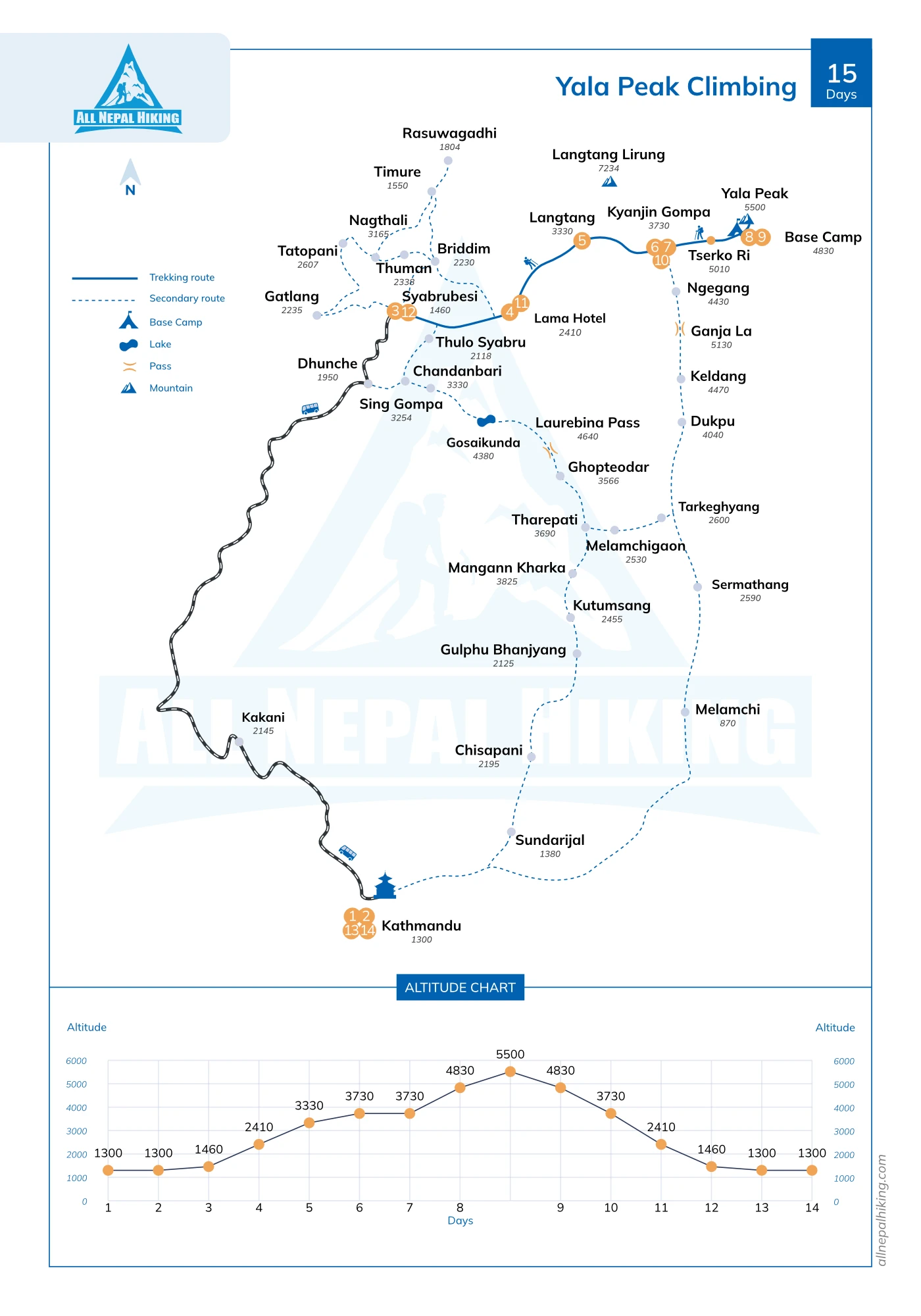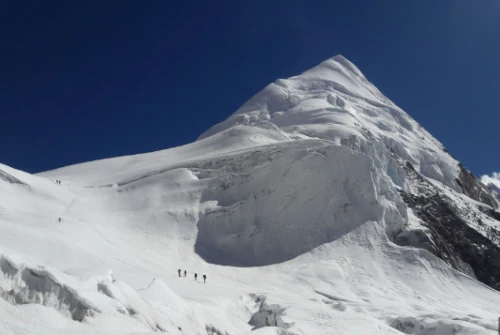Yala Peak Climbing Overview
Yala Peak, rising to 5,500 meters, is one of Nepal’s most accessible and rewarding trekking peaks located in the spectacular Langtang region of the Himalayas. This climb is particularly suited for beginner climbers and adventure seekers with good physical fitness who want to experience high-altitude mountaineering without requiring advanced technical climbing skills. The ascent offers a perfect balance of challenge and accessibility, making it an excellent choice for those looking to start their Himalayan climbing journey or add a non-technical peak to their climbing resume.
The expedition begins with a scenic drive from Kathmandu to Syabrubesi, the gateway to the Langtang Valley. From there, trekkers follow a trail along the Langtang River, gradually ascending through dense rhododendron and bamboo forests. Along the way, you’ll pass through remote Tamang villages, where you can experience the unique Tibetan-influenced culture and warm hospitality of the local people. This cultural immersion adds an enriching dimension to the trek, connecting climbers to the region’s heritage.
As the trek progresses, the terrain shifts to high-altitude yak pastures, glacial moraines, and alpine landscapes before reaching Yala Base Camp at approximately 4,800 meters. The steady and gradual climb provides vital acclimatization time, crucial for adapting to the thinner mountain air and reducing the risk of altitude sickness. Base camp is the perfect place to prepare for the summit attempt, with stunning views of the surrounding peaks.
Though considered a non-technical climbing peak, the final summit push requires basic mountaineering equipment such as crampons, ice axes, and ropes. Under the expert guidance of an experienced climbing guide, you’ll navigate icy slopes and snowy ridgelines safely. The climb demands physical endurance but remains manageable, making it one of the top choices for novice climbers wanting a real taste of Himalayan mountaineering.
Reaching the summit of Yala Peak is an exhilarating and unforgettable achievement. From the top, climbers are rewarded with breathtaking panoramic views of iconic Himalayan giants including Langtang Lirung, Ganesh Himal, Dorje Lakpa, and the majestic Shishapangma, one of the world’s 8,000-meter peaks visible from the summit. On a clear day, you can even gaze out over the vast Tibetan Plateau just kilometers to the north.
In addition to the physical challenge and natural beauty, Yala Peak climbing offers cultural depth and connection, making it a fulfilling adventure for those seeking both thrills and insight into Nepal’s remote mountain communities. Whether you want to start your journey into high-altitude climbing or simply experience a stunning Himalayan trek, Yala Peak delivers a perfect mix of adventure, culture, and spectacular mountain scenery.
Why Choose Yala Peak Climbing in Nepal?
Yala Peak is a top choice for beginner climbers and trekking enthusiasts looking to experience Himalayan mountaineering without requiring prior technical skills. This peak is ideal for those with good physical fitness who want to embark on their first high-altitude climbing adventure. Unlike more challenging technical expeditions, Yala Peak demands basic preparation but no advanced mountaineering experience, making it a perfect getaway for aspiring climbers.
The climbing route features a well-structured 15 day itinerary that balances adventure with accessibility, making it suitable for trekkers with limited time but high ambitions. This relatively short expedition offers an unforgettable mix of trekking and mountaineering, allowing climbers to enjoy the rugged beauty of the Langtang region while gradually acclimatizing to high altitudes.
One of the most compelling reasons to choose Yala Peak is the stunning panoramic Himalayan views available from the summit. From 5,500 meters, climbers are treated to spectacular vistas of famous peaks such as Langtang Lirung, Ganesh Himal, Dorje Lakpa, and most notably, Shishapangma, the only 8,000-meter peak located entirely in Tibet. These rare mountain views make Yala Peak a unique and highly rewarding climb for mountain photographers and nature lovers alike.
In contrast to heavily trafficked routes like Everest Base Camp and the Annapurna Circuit, the Langtang Valley offers a more peaceful and less crowded trekking environment. The serene trails provide a quieter, more intimate connection with the Himalayan wilderness, perfect for climbers seeking solitude and authentic mountain experiences.
Cultural immersion is another highlight of the Yala Peak expedition. The trek passes through traditional Tamang villages and visits ancient Buddhist monasteries, offering rich insights into the region’s unique Tibetan-influenced culture. Interacting with local communities and witnessing their customs enhances the overall climbing experience, making it more meaningful beyond the physical challenge.
In summary, Yala Peak climbing is an excellent choice for first-time mountaineers and trekkers who want a rewarding, beginner-friendly Himalayan peak with spectacular mountain views, peaceful trails, and rich cultural encounters. Whether you are starting your mountaineering journey or seeking an unforgettable Himalayan trekking experience, Yala Peak in Nepal offers an ideal adventure.
What Makes Yala Peak Climbing Special?
Yala Peak stands out as a unique and accessible trekking peak nestled within the breathtaking Langtang National Park, located just north of Kathmandu and near the Tibetan border. This region is renowned for its pristine natural beauty, diverse landscapes, and rich cultural heritage, making the Yala Peak expedition more than just a climb; it's a full Himalayan experience.
The classic 15-day Yala Peak itinerary guides climbers through enchanting rhododendron forests, remote and traditional Tamang villages, serene alpine meadows, and rugged glacial moraines. This gradual ascent allows for proper acclimatization while immersing trekkers in some of Nepal’s most spectacular natural and cultural environments. Along the way, climbers gain insight into the local lifestyle, traditions, and spirituality, deepening the connection to the region.
While Yala Peak is classified as a non-technical peak, the final summit push is both demanding and thrilling. It requires the use of basic mountaineering gear such as crampons, an ice axe, ropes, and a climbing harness to safely navigate the icy ridges and snowy slopes. Under the guidance of experienced climbing leaders, this section offers a true alpine experience that is challenging but achievable for climbers with moderate fitness and determination.
Reaching the summit rewards adventurers with jaw-dropping panoramic views of the surrounding Himalayan giants. Highlights include the impressive Langtang Lirung, Dorje Lakpa, Ganesh Himal, and the majestic Shishapangma, the only 8,000-meter peak located entirely in Tibet and visible from the top of Yala Peak. These unparalleled vistas, combined with the journey through some of Nepal’s most scenic and culturally rich terrain, make Yala Peak climbing a truly special and unforgettable Himalayan adventure.
Who Should Join Yala Peak Climbing?
Yala Peak climbing is an excellent choice for anyone eager to experience Himalayan peak climbing in Nepal without the demands of a lengthy or highly technical expedition. This trek-and-climb adventure is perfectly suited for climbers who are physically fit and mentally prepared to handle the challenges of high-altitude trekking, including rugged terrain and variable weather conditions. If you’re looking for a manageable yet rewarding introduction to mountaineering in the Himalayas, Yala Peak offers just the right level of challenge.
Additionally, Yala Peak appeals to those who prefer a quieter, less commercial trekking route compared to the more popular and crowded trails of Everest Base Camp or the Annapurna Circuit. The Langtang region provides a serene and pristine environment where you can enjoy peaceful trails and untouched natural beauty.
Beyond the physical and natural attractions, Yala Peak climbing offers rich cultural immersion opportunities. Trekkers pass through traditional Tamang villages and interact with Tibetan-influenced communities, gaining meaningful insight into local customs, traditions, and spiritual practices. This blend of adventure and cultural experience makes Yala Peak ideal for travelers seeking more than just a physical challenge a journey that enriches both body and soul.





 based on 1 review
based on 1 review